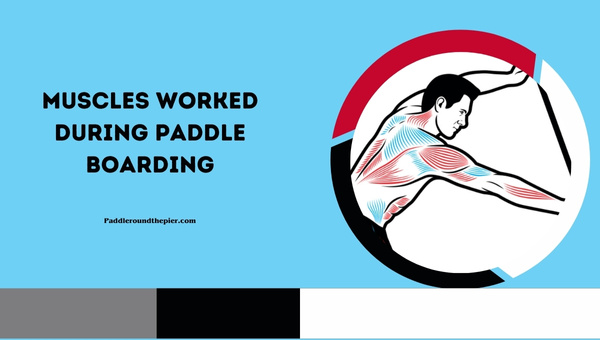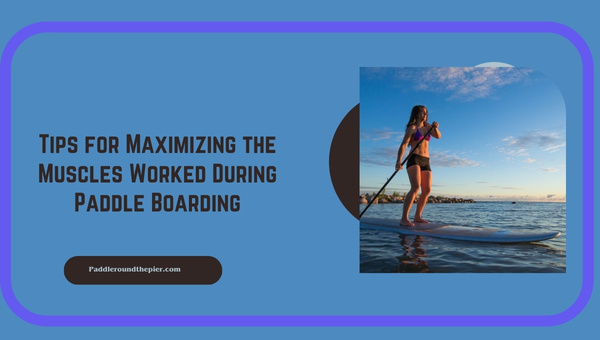Muscles Worked during Paddle Boarding: The Benefits
Paddleboarding has seen a surge in popularity over recent years, and it's not just because of the fun and relaxation it offers. Among its myriad of benefits, one aspect of paddleboarding that truly piques my interest is the amazing array of muscles worked during paddleboarding. It's like a comprehensive fitness regime on water!
This dynamic water sport doesn't just offer a great excuse to soak up some sun; instead, it provides an opportunity to engage several muscle groups that you might not typically use in your regular gym workout. From boosting your upper body strength to firming up your core and enhancing your balance — paddleboarding essentially offers an extensive full-body activity. But don't take my word for it just yet.
In This Article Discover:
- The key muscle groups in paddle boarding that get you shredded.
- How paddle boarding muscles contribute to a comprehensive paddle board workout.
- Surprising paddle boarding fitness benefits beyond toning muscles, including cardiovascular benefits.
- Useful tips on how to boost efficiency for working more muscles during paddle boarding.
Muscles Worked During Paddle Boarding
When thinking about paddle boarding muscles, as an outdoor enthusiast myself, I find it's often overlooked that paddle boarding isn't just a relaxing way to venture into serene waters.

It's also a killer full-body workout. What muscles does paddle boarding work? More than you would expect!
Core Muscles
Gracefully standing upright on that board while steering and stabilizing yourself demands serious muscle engagement. Here’s where your core comes into play. Heck, the sport could be renamed ‘Dynamic Planking’ because of the array of core muscles in paddle boarding that are activated throughout your session.
- Abs: Both your rectus abdominis (the "six-pack" muscles) and transverse abdominis are heavily engaged as you work to maintain your balance on water, which can be unpredictable.
- Obliques: Have you ever wondered why seasoned paddleboarders have toned side abs? The secret lies within their obliques! This muscle group helps in controlling the board’s rotation and aids in paddling.
- Lower Back Muscles: Dominantly, the erector spinae and multifidus will take a hit. Regular paddleboarding can help strengthen these lower back muscles, which can prevent potential back pain issues in the future.
With every stroke of paddling, it feels like these core powerhouses get stronger, granting you a beautiful definition of your torso. Who wouldn't love that?
Upper Body Strength
Wielding a long oar to glide through the water gracefully might look effortless from afar, but it requires hard work from various upper body parts.
- Shoulders and Upper Arms: The rotator cuff muscles, along with your deltoids, enjoy a significant workout during each stroke. A deeper understanding of rotator cuff muscles will highlight their importance in functions like paddling. Your biceps & triceps engage heavily when pulling or pushing through each stroke, respectively.
- Forearms: The continual grasping on the oar provides rigorous exercise for forearm flexors, enhancing your grip strength.
- Back Muscles: It may surprise some, but paddleboarding is as much a back workout as it is core. Particularly, the muscles like latissimus dorsi ("lats") and rhomboids are up for providing power to paddle strokes while maintaining an upright posture.
Ultimately, paddle boarding fitness benefits go far beyond just burning calories - It's an upper body workout in SUP that has made me toss out my gym membership altogether!
Also Read: Red River Gorge Kayaking: Explore the Breathtaking Beauty
The Full-Body Workout of Paddle Boarding
Getting on a paddle board not only allows you to soak up sunlight and enjoy the natural scenery, but it also provides an incredible full-body workout, affecting virtually every muscle group – even those we might overlook like our Pectoralis major. Let's take a closer look at how this occurs.
Comprehensive Toning
Anyone interested in achieving comprehensive body toning should strongly consider the paddle boarding fitness benefits. Here's why:
- Full Engagement: Essentially, every muscle in your body is working to some degree during a paddleboarding session - whether you are paddling, balancing, or merely standing upright on your board.
- Effective Fat Burn: The cumulative effects of the muscles worked during paddle boarding translate into a substantial calorie burn that can promote weight loss and overall toning according to research published in the National Library of Medicine (source).
- Increased Metabolism: Extensive use of muscles during this water activity contributes to an increased metabolic rate.
Let's not forget that the process of repetitive paddling works both sides of the body equally, promoting balanced strength and toning.
Lower Body Muscles
While it might seem like mainly an upper-body activity, don't underestimate the influence paddle boarding has on your lower body. Your legs are continually engaged as you maintain balance and control the board’s direction with slight shifting movements.
Here’s how various lower body muscles come into play when I hit the water with my SUP:
- Leg stability: Your thighs, hamstrings, and calves all work in unison as stabilizing forces while you're atop your SUP.
- The Core Connection: Strong legs partnered with working core muscles contribute significantly to balance improvement during paddle boarding.
- Footwork: Believe it or not, even small intricate foot movements are required for efficient balance adjustment—resulting in subtle continual exercise for foot and ankle muscles.
By targeting these vital muscle groups during paddle boarding workouts, you can build powerful lower extremities capable of tackling challenging water conditions. Plus, there's the bonus of astoundingly toned leg muscles!
The point here is simple yet profound—paddle boarding delivers a full-body workout like few other activities can. Whether your goal is comprehensive toning or you're just looking to ramp up your fitness routine in general, you'll find it to be a uniquely effective, enjoyable exercise regime. So why wait? Grab that paddle and board—it's time to make some waves!
Also Read: Unlocking the Top 10 Kayaking Rules for Safe, Fun Adventures
Advantages of Paddle Boarding Beyond Building Muscle
While the muscle-building benefits of paddle boarding cannot be understated, there are additional, equally impressive, rewards that come with this full-body workout. From cardiovascular improvement to honing balance skills, paddleboarding is a comprehensive health package. I'll take you through these extraordinary perks.
Cardiovascular Benefits
Paddle boarding isn't just about working your muscles - it's a fantastic cardiovascular exercise, too! Imagine getting a great cardio workout while soaking in the soothing serenity of gliding over water. Isn't that an appealing picture? Here's how paddle boarding keeps your heart ticking along nicely:
- Heart Health: The consistent paddling action spikes your heart rate, which enhances cardiovascular health similarly to running, CrossFit, or aerobics.
- Stamina Boost: Regular sessions on the paddleboard increase endurance. It means not only will I stay on the board longer, but also have more energy in my everyday life.
- Full-Body Blast: The simultaneous engagement of multiple muscle groups during paddle boarding results in superior calorie burn compared to many other exercises. This aids weight management and boosts metabolism, playing a key role in maintaining heart health.
Balance Improvement
Another noticeable advantage of paddle boarding is enhanced balance. Now, I don’t mean just physical balance – though it definitely develops that! By consistently engaging numerous muscles on a slightly unstable platform like a paddleboard it increases my proprioception skills – my sense of self-movement and body position.
- Core Stabilisation: Paddleboarding forces me to use my core muscles for stability constantly. Over time, this drastically improves balance and strength.
- Improves Focus: Have you ever tried staying balanced while waves rock my board? It requires intense focus and constant adjustment - an excellent way of training both mind and body.
- Joint Health: Unlike high-impact workouts that can strain joints over time, paddleboarding is low-impact yet highly effective. Improved proprioception also means less clumsy moments and reduced risk of related injuries.
Tips for Maximizing the Muscles Worked During Paddle Boarding
Maximizing the muscles worked during paddle boarding takes more than just going out in the water and paddling away. It's a blend of using the correct technique, engaging the right muscle groups, and recognizing when to push harder or take it down a notch.

Discussion on efficient paddling techniques that work more muscles.
Optimal paddling strategies can make an enormous difference, not just ensuring you catch those waves more efficiently but also making sure you're getting as much of a workout as possible out of each paddle-boarding session. With this in mind, let's delve into some key points to optimize muscles' engagement:
- Rotating your torso: In paddleboarding, many tend only to use their arms for propulsion. However, adding torso rotation into each paddle stroke can be transformative; it gives you more power and reduces arm fatigue by engaging your core muscles.
- Keeping hands shoulder-width apart: Your grip plays an essential role in effective paddling. By keeping your hands at shoulder width or slightly wider on the paddle shaft provides a direct line of power from your upper body through the lower body.
- Bending knees slightly: Keeping knees slightly bent assists with balance and engages lower body muscles like quads and glutes.
- Standing tall: Aim to keep your back straight and maintain good posture throughout. This technique helps work the core muscles while balancing on board.
FAQs
What muscles do you use most when you are paddleboarding?
Paddle boarding is a full-body workout that extensively engages your core muscles. It also targets your shoulders, arms, and back in the upper body and the legs' muscles for stability and balance on the board.
Is Paddleboarding a good full-body workout?
Absolutely! Paddleboarding simultaneously works on multiple muscle groups from head to toe, providing comprehensive toning. It also enhances cardiovascular health and improves balance, making it an excellent full-body workout.
How often should I be doing it for maximum benefit?
The frequency of paddle boarding varies per person; however, I suggest incorporating it into your routine at least three times a week to experience noticeable fitness benefits.
Conclusion
All in all, feeling the sun on my skin while paddle boarding across the water is not just relaxing, it also makes a significant impact on my fitness. Contrary to popular belief, paddle boarding does more than work your arms - it's a full-body workout.
From building core strength to enhancing balance and boosting cardiovascular health, it offers multiple benefits! With efficient paddling techniques, I can ensure to maximize the muscles worked during paddle boarding.
Key Takeaway Points
- Paddleboard workouts engage and strengthen various core muscles.
- Paddleboarding provides an all-encompassing upper body workout, working out the shoulders, arms, and back.
- Beyond muscle building, it offers great cardiovascular exercise.
- Regular paddle boarding is excellent for improving your balance and proprioception skills.
